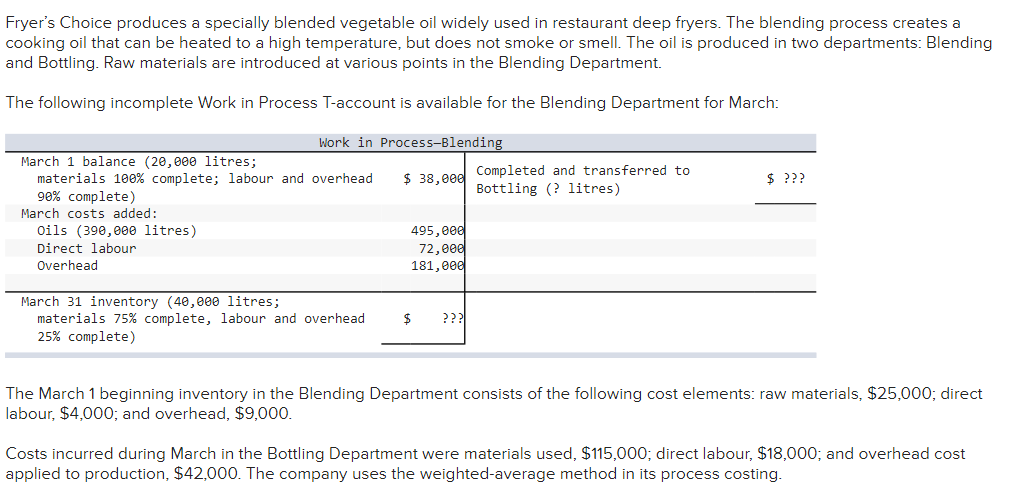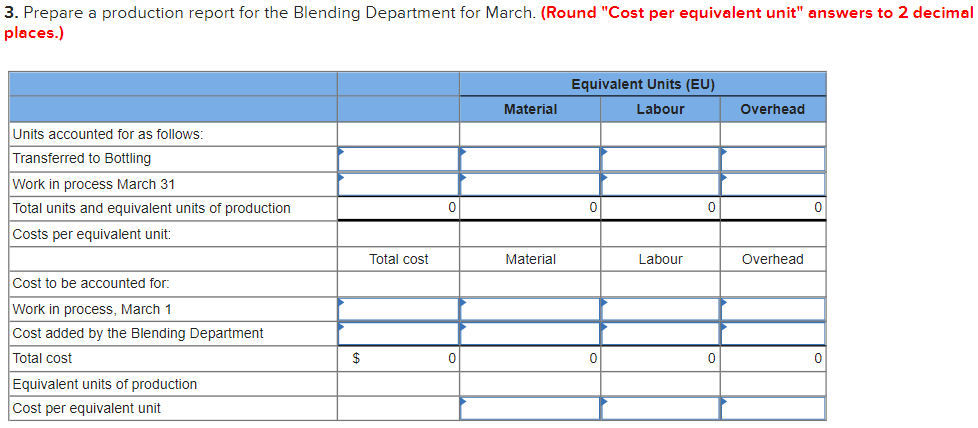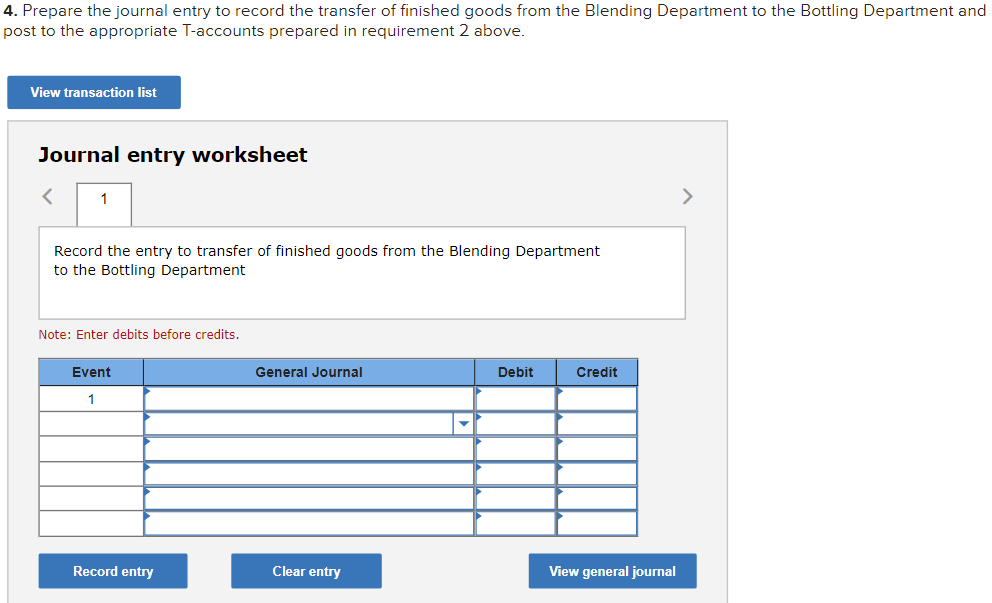





Fryer's Choice produces a specially blended vegetable oil widely used in restaurant deep fryers. The blending process creates a cooking oil that can be heated to a high temperature, but does not smoke or smell. The oil is produced in two departments: Blending and Bottling. Raw materials are introduced at various points in the Blending Department. The following incomplete Work in Process T-account is available for the Blending Department for March: The March 1 beginning inventory in the Blending Department consists of the following cost elements: raw materials, $25,000; direct labour, $4,000; and overhead, $9,000. Costs incurred during March in the Bottling Department were materials used, $115,000; direct labour, $18,000; and overhead cost applied to production, $42,000. The company uses the weighted-average method in its process costing. 1. Prepare journal entries to record the cost incurred in both the Blending Department and the Bottling Department during March. Key your entries to the items (a) through ( f ) below: a. Raw materials were issued for use in production. b. Direct labour costs were incurred. c. Manufacturing overhead costs for the entire factory were incurred: $225,000. (Hint: Credit Accounts Payable.) d. Manufacturing overhead cost was applied to production using a predetermined overhead rate. e. Units that were complete with respect to processing in the Bottling Department were transferred to finished goods: $950,000. f. Completed units were sold on account: $1,500,000. The cost of goods sold was $890,000. 2. Post the journal entries from requirement 1 above to T-accounts. The following account balances existed at the beginning of March. (Note: The beginning balance in the Blending Department's Work in Process account is given above.) After posting the entries to the T-accounts, find the ending balance in the inventory accounts and the manufacturing overhead accounts. Prepare a production report for the Blending Department for March. (Round "Cost per equivalent unit" answers to 2 decimal places.) 4. Prepare the journal entry to record the transfer of finished goods from the Blending Department to the Bottling Department and post to the appropriate T-accounts prepared in requirement 2 above. Journal entry worksheet Record the entry to transfer of finished goods from the Blending Department to the Bottling Department Note: Enter debits before credits. Fryer's Choice produces a specially blended vegetable oil widely used in restaurant deep fryers. The blending process creates a cooking oil that can be heated to a high temperature, but does not smoke or smell. The oil is produced in two departments: Blending and Bottling. Raw materials are introduced at various points in the Blending Department. The following incomplete Work in Process T-account is available for the Blending Department for March: The March 1 beginning inventory in the Blending Department consists of the following cost elements: raw materials, $25,000; direct labour, $4,000; and overhead, $9,000. Costs incurred during March in the Bottling Department were materials used, $115,000; direct labour, $18,000; and overhead cost applied to production, $42,000. The company uses the weighted-average method in its process costing. 1. Prepare journal entries to record the cost incurred in both the Blending Department and the Bottling Department during March. Key your entries to the items (a) through ( f ) below: a. Raw materials were issued for use in production. b. Direct labour costs were incurred. c. Manufacturing overhead costs for the entire factory were incurred: $225,000. (Hint: Credit Accounts Payable.) d. Manufacturing overhead cost was applied to production using a predetermined overhead rate. e. Units that were complete with respect to processing in the Bottling Department were transferred to finished goods: $950,000. f. Completed units were sold on account: $1,500,000. The cost of goods sold was $890,000. 2. Post the journal entries from requirement 1 above to T-accounts. The following account balances existed at the beginning of March. (Note: The beginning balance in the Blending Department's Work in Process account is given above.) After posting the entries to the T-accounts, find the ending balance in the inventory accounts and the manufacturing overhead accounts. Prepare a production report for the Blending Department for March. (Round "Cost per equivalent unit" answers to 2 decimal places.) 4. Prepare the journal entry to record the transfer of finished goods from the Blending Department to the Bottling Department and post to the appropriate T-accounts prepared in requirement 2 above. Journal entry worksheet Record the entry to transfer of finished goods from the Blending Department to the Bottling Department Note: Enter debits before credits












